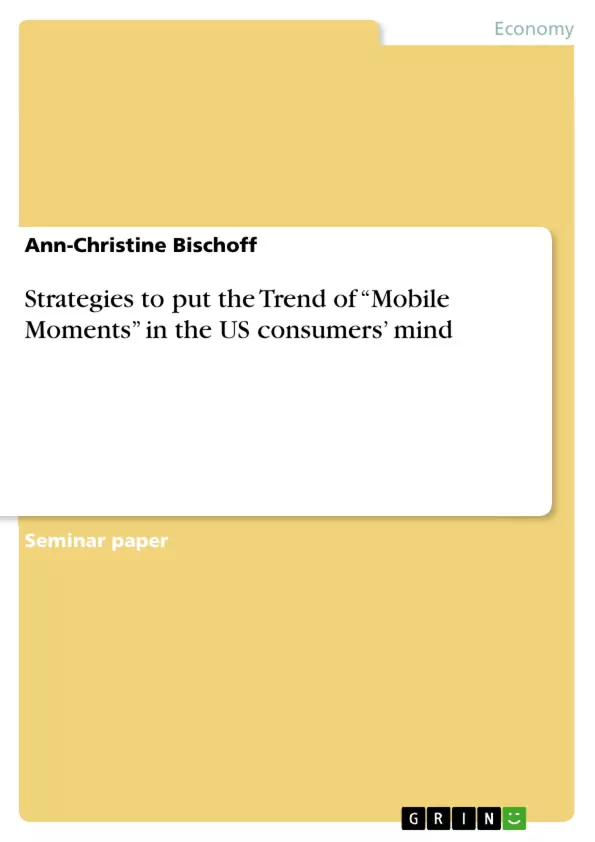As Steve Jobs used to say: “It isn’t the consumers’ job to know what they want.” Referring to this famous quote, this report examined how the upcoming trend can be implemented in the US con- sumers mind, so that the consumer behaviour is sustainably changed. In order to give advice the report follows three mayor steps.
First the cultural framework of the United States was briefly analysed by help of Hofstedes five dimensions model. Second was a short study of the trend itself and the mayor aspects, which are important for an implementation of the trend. Last step was adaptation of the US consumers’ behav- iour to the trend in order to detect the key factors a company should cover with their product.
Based on this set of action were developed and recommendations for companies evolved.
Inhaltsverzeichnis (Table of Contents)
- Introduction
- The culture of the United States
- Power Distance
- Individualism versus Collectivism
- Masculinity versus Femininity
- Uncertainty Avoidance
- Long-Term Orientation
- Mobile Moments
- Link between "Mobile Moments" and the US consumers
- Lifestyle of Multitasking
- Experience as a core value
- Sharing moments with friends
- Result
- How to apply "Mobile Moments” in the US consumers mind.
- US Mobile Market
- Set of Actions
- Conclusion
Zielsetzung und Themenschwerpunkte (Objectives and Key Themes)
This report investigates the "Mobile Moments" trend and its application to US consumers. It aims to provide companies with actionable insights on how to successfully integrate this trend into their products and services. The key themes explored in this report include:- Understanding the cultural context of US consumers through Hofstede's cultural dimensions model
- Analyzing the "Mobile Moments" trend and its core aspects
- Examining the relationship between the "Mobile Moments" trend and US consumer behavior
- Developing strategies for companies to adapt their offerings to effectively leverage the "Mobile Moments" trend
- Identifying key factors that influence US consumer behavior in the context of mobile technology and the "Mobile Moments" trend
Zusammenfassung der Kapitel (Chapter Summaries)
- Introduction: This chapter introduces the concept of "Mobile Moments" as a relevant trend for companies seeking to stay competitive in the market. It emphasizes the importance of understanding consumer behavior and cultural influences for successful product implementation.
- The culture of the United States: This chapter explores the cultural context of the US using Hofstede's five cultural dimensions: Power Distance, Individualism versus Collectivism, Masculinity versus Femininity, Uncertainty Avoidance, and Long-Term Orientation. The chapter analyzes the US's position on each dimension, providing insights into the values and attitudes that shape consumer behavior.
- Mobile Moments: This chapter delves into the "Mobile Moments" trend, highlighting its emergence as a consequence of the rapid adoption of smartphones and tablets. It explores how this trend impacts consumer behavior, emphasizing the demand for efficient and experiential mobile experiences.
- Link between "Mobile Moments" and the US consumers: This chapter examines the specific relationship between the "Mobile Moments" trend and US consumer behavior. It analyzes the lifestyle of multitasking, the growing importance of experience, and the desire to share moments with others as key factors driving the trend's influence.
- How to apply "Mobile Moments” in the US consumers mind.: This chapter provides actionable strategies for companies to adapt their products and services to effectively leverage the "Mobile Moments" trend in the US market. It examines the US mobile market, discusses a set of actions to consider, and emphasizes the importance of addressing key factors influencing consumer behavior in this context.
Schlüsselwörter (Keywords)
This report focuses on the "Mobile Moments" trend and its impact on US consumers. Key terms include: "Mobile Moments," consumer behavior, US culture, Hofstede's cultural dimensions, mobile technology, smartphone, tablet, multitasking, experience, sharing, mobile market, product adaptation, and company strategy.- Quote paper
- Bachelor of Arts Ann-Christine Bischoff (Author), 2013, Strategies to put the Trend of “Mobile Moments” in the US consumers’ mind, Munich, GRIN Verlag, https://www.grin.com/document/275120



